I’ve often mentioned the book Uplift: The Bra in America, by Jane Farrell-Beck and Colleen Gau. It’s scholarly but also very readable, and packed with related information on women’s lives. It feeds my interest in old advertisements, too — I’ll be sharing a small selection of underwear ads and patterns from the 1920’s and 1930’s in several posts.
Note: This post is not an authoritative history of the brassiere; for that, please consult both Uplift and Fashion in Underwear by Elizabeth Ewing. The topic is so complicated that the Wikipedia entry warns of contradictions.
I’m indebted to the authors of Uplift for this concept:
For hundreds of years, women’s breasts were supported by corsets, which pushed them up from below. The innovation of the twentieth century was “uplift” — shoulder straps which supported the weight of the breasts from the shoulder instead of pushing them up from beneath.
First, a brief visual tour of early 20th century brassieres:
At the beginning of the 20th century, fashion was still in the “monobosom” or “unibosom” era.
Corset boning probably ran up the center of these brassieres and also over the breasts to create a smooth bulge without any breast separation. “By 1917 brassieres [like those above] had moved from a minority fashion to the mainstream of womenswear.” Uplift, p. 33.
The tubular, boyish ideal of the early 1920’s led to a brief fashion for flattening the breasts. See Underpinning the 1920s: Brassieres, Bandeaux, and Bust Flatteners. There was even a brassiere company called “Boyshform,” (boyish form) and another called “Flatter-U.”
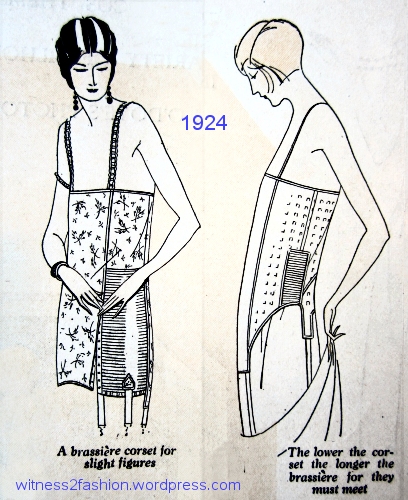
New corsets and brassieres, Delineator, February 1924, p. 23. On the right, a very long flattening brassiere.
When young women stopped wearing restrictive underwear in the 1920’s and allowed two separate breasts to be discerned, those with youthful figures might wear an unstructured brassiere primarily to prevent their nipples from showing through the lightweight dress fabrics that were popular.

1927: (right) Butterick pattern 1534 for a bra and matching step-in panties. July 1927, Delineator, 1927.

1926: Butterick pattern 6961 for a bandeau brassiere and frilled bloomers; Delineator, July 1926, p. 38.
For me, there are two interesting things about this pattern. 1) This 1926 brassiere is definitely divided into two separate pockets (The phrase “bra cup” had not yet been invented.) It is not meant to flatten the bust. 2) It appeared on the same page as this pattern — No. 6964 — for two bust-flattening brassieres:
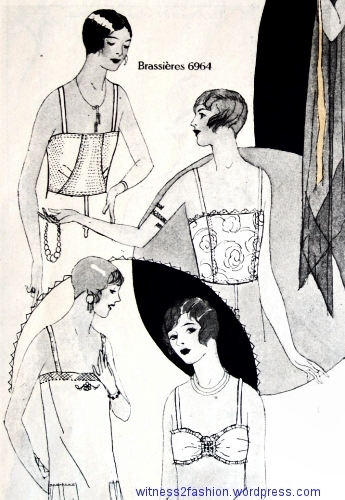
1926 brassiere patterns from Butterick. At top, two bust flatteners, pattern 6964. At bottom right, pattern 6961 for a brassiere that separates and does not flatten the breasts. Delineator, July 1926, p. 38.
Obviously, 1926 was a year of transition. Next, Part 2: The Uplift Idea in 1920’s Brassieres.

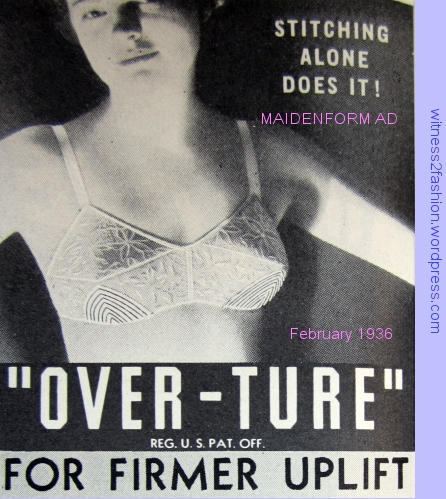
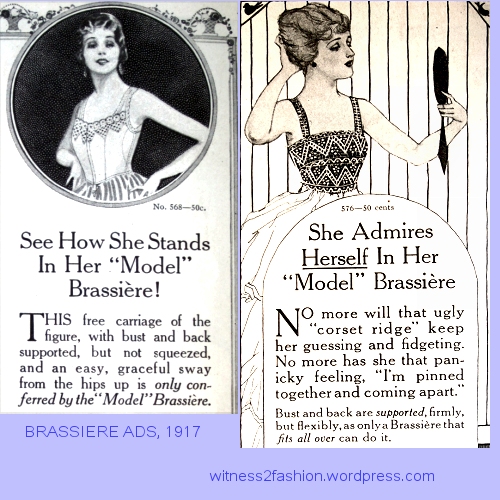
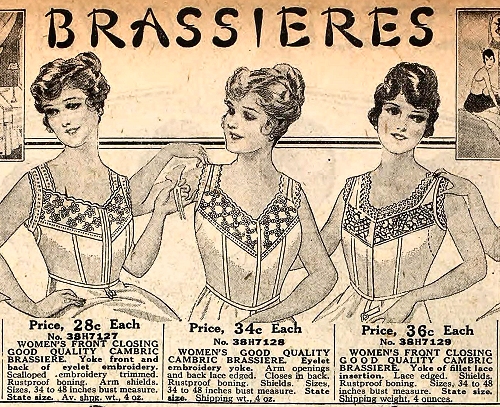

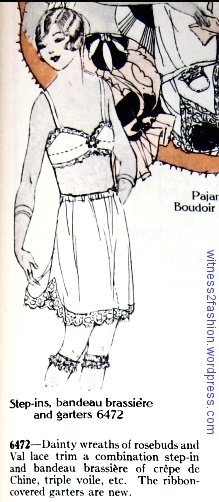
This got me thinking. Was nipples showing throught outer garments a concern in those days? It is today, clearly, but I have the impression that it’s far more of a concern in North America than it is in Europe, and I really don’t remember it being something I ever thought of 20 years or so ago. Granted, I’m in Sweden and we are culturally not that concerned about nudity overall, on a Western scale. Topless sunbathing was fairly common among adult women on beaches when I was a kid in the 80’s, although it is not nearly as frequent now.
Anyway: I don’t think I’ve ever seen it referred to explicitly in old advertisements and texts, but perhaps it wouldn’t be? Support, silhouette and breast movement are my own primary concerns – I honestly don’t care if there’s a glimpse of nipple outline.
Movies from the 1920s and 1930s sometimes show a glimpse or outline of nipples (or a bare breast), but American movies were censored and self-censored after 1934. Pre-Code movies had lots of undressing scenes, good for seeing lingerie…. Joan Blondell movies, especially. Jean Harlow wore clinging silk dresses and her nipples were the source of comments (did she ice them to make them prominent, or did she have to warm them to prevent them from showing?) And the shock of seeing women in thin 1920’s dresses on a chilly night must have been part of the scandalous “no corset” effect. I think it is largely an American concern. Americans had a breast fixation in the 1950’s, but it probably started in the thirties. I never liked to wear padded bras, and padding is really the only way to the way the body reacts to a cold day….
Yes, I recall seeing quite a bit of skin on Blondell in Gold Diggers of 1933, and other pre-codes too. Most of the Swedish films I’ve seen from that era are pretty chaste, actually, but adult topics are discussed in a different way.
There’s a 1943 version of Münchhausen, though, commissioned by Goebbels for the 20th or 25th anniversary of the German film studio UFA, which is quite rowdy and features full-on nudity, IIRC. It’s a great, beautiful spectacle in colour, with scenes filmed with a ton of extras in costumes on location in Venice and all. There’s no Nazi propaganda in it, so I recommend it. I think it was marketed as a lavish matinée adventure film for the whole family.
Sorry, I see that I posted the first comment on another account, by the way – same person, I just have two different accounts that get mixed up.
Pingback: Modart Corset Ad, March 1928 | witness2fashion
Pingback: Underneath Those Twenties’ Fashions | witness2fashion
Pingback: More “WTFashion?” Ads from Delineator: Bust Confiners (1900s) to Brassieres (1920s) | witness2fashion